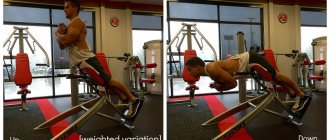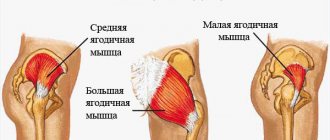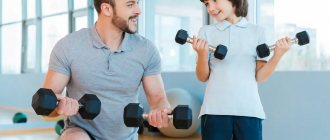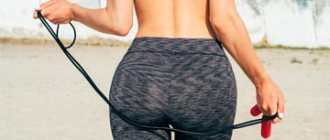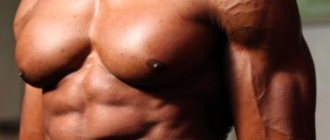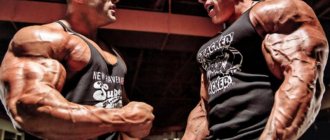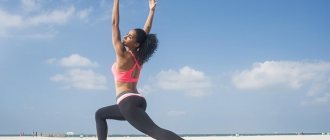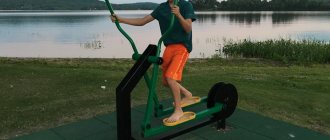A beautifully defined buttock shape is the dream of many. A sedentary lifestyle leads to loss of tone, sagging skin, and accumulation of fat in this area. In order to burn fat and build muscle in the buttocks, some even start running. But not everyone manages to achieve the elasticity and fit of the fifth point, even after a series of grueling workouts. Today we will find out whether running is good for your legs and buttocks, the basic rules of such running training, and also consider individual sets of effective exercises.
Further:
Running techniques for training the gluteal muscles
Standard jogging at a measured pace works well for the rectus and biceps femoris muscles, as well as quadriceps, but for the gluteal muscles they are ineffective. This requires special techniques.
- Running with acceleration. Part of the distance must be run at maximum speed, increasing it both due to the length of steps and due to cadence. Accelerations should be done in short bursts of 15 seconds, after which work according to the following scheme: 1 minute of light jogging - 1 minute of running at an average pace - 2 minutes of light jogging. You need to repeat the cycle for 10–45 minutes without pauses, depending on your level of training.
- Run uphill and downhill. You need to run at an average pace to the top of the hill - at the beginning of training it is gentle, gradually you can choose steeper climbs. In this case, the foot should first land on the toe and then on the heel, then due to the pushing movements the gluteal muscles are more actively involved. When descending, you need to land on your entire foot at the same time.
- Run up and down the stairs. The pace is average, the total duration (excluding breaks) is about half an hour.
- Running with swollen legs. When jogging, you need to do approaches of 2-3 minutes, during which, when throwing your leg back, raise your heel as high as possible.
Is it possible to tighten your butt by running?
The gluteal muscle is one of the most massive in the human body. The width and shape of the buttocks depends on it. In addition to the aesthetic effect, the gluteal muscles are responsible for maintaining posture and protecting joints. Also, the degree of their training determines the plasticity and grace of their gait, as well as the attractiveness of the body’s topography, which is why there are so many who want to improve the appearance of this area.
Running is a universal workout that provides stress on all muscle groups, the gluteal muscles are no exception. During jogging they train:
- Soleus muscle
- Biceps hamstrings
- Quadriceps femoris
- Calf and gluteal muscles
Thus, the benefits of running are obvious: it involves almost the entire lower body. As a result, the percentage of fat content decreases and the muscles of the buttocks and legs are toned. To pump up the gluteal area, only high-intensity running is suitable, including intervals, jogging, raising the hips or throwing the heel behind the back.
But it is impossible to achieve an appetizing butt shape by running alone. You can increase the intensity of the impact on the desired area using simple techniques. Running for the buttocks should be combined with a set of exercises, in particular, squats, bending over with weights, lifting the pelvis from the floor, etc.
Training equipment
A few important notes on clothing and shoes for training.
- Alternate two pairs of sneakers with different types of soles to load different groups of muscle fibers and achieve a more pronounced relief.
- Train in pants or shorts made of modern high-tech materials that effectively wick away moisture. A good example is the PUMA sweatpants with dryCELL technology. Only with good thermoregulation will metabolism in the muscles be truly effective.
- Don't forget about preventative knee pads. Training for the buttocks is associated with non-standard and often explosive loads, which means that the risk of injuring joints and ligaments increases. Knee pads will help prevent this.
What muscles work on a treadmill?
In fact, during running, almost the entire body is involved, the legs swing, but mainly the muscles of the lower extremities work :
- gastrocnemius;
- soleus;
- quadriceps femoris;
- hamstring biceps;
- gluteal
When running, the leg muscles work fully, but the emphasis on certain muscle groups depends on the running technique used. Let's focus our attention on this.
In addition, while running the following work:
- lower part of the rectus abdominis muscles;
- muscles of the shoulder girdle and chest;
- core muscles.
The more actively you move while running (using rhythmic arm swings or something else), the more muscles are involved. In addition, even more muscles are activated during longer and higher loads. As a result, it is also effective for losing weight in the legs.
More details about which muscles work on the treadmill are described here.
Important! Running doesn’t so much build muscles and help you lose weight in your legs and buttocks, but rather it dries your body and gives you a more defined profile. Therefore, if you want to pump up large buttocks, additional exercises will be required.
Proper recovery after running
For harmonious muscle development, not only training is important, but also control over metabolic processes - that is, recovery after exercise. If there is not enough rest, instead of growing, muscle mass will begin to decrease. To prevent this from happening, you can use the following recommendations:
- use the services of sports massage therapists or master effective self-massage techniques;
- in the absence of contraindications, visit a bathhouse or sauna to improve blood circulation;
- use the “carbohydrate window” and within 1-2 hours after training, eat something high in slow carbohydrates - for example, muesli with nuts and dried fruits.
After a couple of months of training three times a week, following all these rules, positive changes will become noticeable to the naked eye. The main thing is to maintain regularity.
Rules for running to strengthen your buttocks
How to run to pump up your butt is a question many beginners ask. To do this you need to follow a few simple rules:
- Warm up before training. This will stretch and warm up the muscles, preparing them for increased stress. Duration – 5-10 minutes.
- Increase the speed gradually, as well as the duration of the workout. At first, running can last about 15-40 minutes. It is especially important for beginners to observe moderation.
- Exercise at least 3 times a week. This will allow you to achieve a noticeable effect after 2-3 months of training.
- Avoid overwork. In this case, there is a temptation to skip a couple of workouts or quit altogether. Regularity is important in training, and strict adherence to a training schedule will allow you to achieve better results than occasional heavy loads.
- Finish your workout with walking. This will allow you to smoothly reduce the number of heart beats and prolong the fat burning process in the body as much as possible.
- Adjust your diet. Sweet, refined, high-fat foods should be avoided. You can also take special vitamins to strengthen muscles.
Technique of running in place
Start by preparing your study area. You will need a free space of no more than one square meter. It is better - near the wall so that you have support.
Lay down a rubber mat. A regular hiking mat (sold in travel stores) or the one you go to yoga with (if you go) will do.
Despite its apparent simplicity, stationary running requires proper execution in order to eliminate unnecessary stress on the joints and achieve maximum efficiency.
The training must include the following steps:
- warm-up;
- directly jogging;
- hitch.
The technique of running in place is as follows:
- the back is straight without twisting left and right;
- the body is positioned level, slightly tilted forward;
- the stomach is slightly retracted;
- knees over feet;
- arms bent at the elbows;
- shoulders and neck relaxed;
- landing on your toes;
- Do not straighten your knees completely.
Warm up by walking, squats, and low swings to warm up your leg muscles and prepare them for the load.
Support will help you understand in what position to start the lesson. Stand up straight, extend your arms parallel to the floor and press your palms against the wall. Bend your elbows slightly, leaning your body forward. Holding onto the wall, alternately raise and lower your legs, as if you were already running, but at a slow pace. Watch your posture and diaphragm. Everything should feel comfortable. As soon as you achieve this feeling, release the support and begin the movement, raising your knees higher. In this position you can begin to exercise.
For beginners, video tutorials, of which there are many posted online, or consultation with a specialist will help. You can go to the gym once and have a trainer correct your posture, especially if you feel unsure or uncomfortable.
Breathing should be smooth and not hesitant. It is optimal to inhale through your nose and exhale through your mouth.
It is imperative to organize access to fresh air - open a window or window, but avoid drafts. If possible, it is good to arrange a place to study on the balcony, especially if it is located on a quiet side of the street or yard. Sufficient oxygen increases calorie burning.
Running in place has several varieties depending on the technique of execution. Which one to choose depends on your physical fitness and general condition of the body.
If there are recommendations to spare the spine, when moving, you should put your hands behind your back and raise your head up.
For people with mental work, it is optimal to jog, flapping their arms, raising their legs high.
Let's take a closer look at the most common types of equipment.
Running with high knees
All general requirements for execution technique apply to this type of movement.
First, walk slowly for 5 minutes. Then it’s good to do push-ups in several approaches. Difficult from the floor - use a sofa or the back of a chair. 10-20 times is enough. The goal is to warm up the muscles of the legs, abdomen, and chest.
After the warm-up, proceed directly to the intensive phase of the workout.
As you run, lift your legs so that your thighs are parallel to the mat. Make sure that the body does not fall back, prevent compression in the lower back.
The shoulders are lowered, the neck is extended, but without tension.
Land on the front of your feet, keeping your heels from hitting the floor, as this has a negative impact on the entire spinal column.
Alternate between slow and fast paces - this increases the efficiency of burning calories.
When moving, the heart contracts more actively, which has a beneficial effect on its endurance and performance.
If there are no medical contraindications, supplement the training with jumping, also raising your knees up.
Finish your session with a cool down. This could be walking again at a calm pace, raising your arms up to deepen your breathing.
Then, lying on the mat, do several exercises to stretch your legs and buttocks.
Running with shin sprains
To improve performance and avoid injury, the warm-up for this type of exercise, in addition to walking, should include bending forward from a standing and sitting position. Try, without rounding your back, to reach the floor or feet with your fingertips, respectively. The goal is to warm up and stretch the back of the thighs, which are actively involved in running.
Keep your hips relaxed and shoulders down. Keep your body level, without leaning forward or backward. Watch your diaphragm (it should not be compressed) and abdomen (abs should be toned).
Land without excessive force to avoid foot injuries.
The exercise improves and expands motor amplitude, increasing the ability for painless dynamics during movement.
Finish with a cool down. Walk slowly, and then lying on the mat, stretch your legs and arms in different directions, lift them up, shake them to relieve tension.
Perform a gentle stretch:
- from a supine position, lift your right leg to an angle of 90 degrees, grab it with your hands and pull it towards the body as far as you can without pain;
- repeat with left leg;
- then bend both legs at the knees, place your palms on them and slightly roll back and forth on your back. This will relieve tension from the lower back.
Video. How to pump up your buttocks without squats
Legs and buttocks: the best exercises at home
How to avoid injuries when running. Stretching tight buttocks.
How to pump up your butt. Butt workout
- >
Legs and buttocks: the best exercises at home
Strength training to strengthen your entire body, avoid injury, and add energy to your run
- >
How to avoid injuries when running. Stretching tight buttocks.
Today I will introduce you to an incredibly effective stretching! What a miracle it is to stretch the muscles of your buttocks. If you often sit or have done a good workout of your buttocks, this stretch is definitely for you!!!
- >
Is it possible to get bigger buttocks just by running?
In short, it is hardly possible to achieve this by running alone. But if you slightly change your approach to exercising on the treadmill, in particular, use the program proposed below, your gluteal muscles will really begin to grow.
Special training and accentuated load will be required. After all, if you take short steps or run at a significant incline, then most of the load is distributed along the front of the thigh. In such a situation, the main muscles grow there.
When you create focused workouts, you improve your glutes. Of course, an indispensable addition to training is proper nutrition and a normal recovery period. By the way, massage and similar auxiliary tools can also help pump up and restore the buttocks.
the TOP 10 ranking of the most effective exercises for lifting the buttocks here.
Does running in place help you lose weight?
Of course yes. Provided you have an irresistible desire, persistence and regularity of exercise, you will notice the effect within a week. It is not at all necessary to give all your best in the gym, lifting weights or circling along the paths of the park. It is quite possible to get the desired result if the morning half hour after getting up includes intense exercise plus running on the spot at home for weight loss.
Maximum benefit is achieved by observing the following rules:
- take training seriously, do not treat it as entertainment;
- strictly adhere to the regime and program of classes, without making concessions to yourself;
- believe in the result and your strengths;
- adjust your diet towards a healthy one.
A beautiful, toned figure is guaranteed to you.
It is possible to burn up to 300 kcal in one intense workout. If you exercise 5-6 times a week, even for 30 minutes, and adhere to a low-calorie diet, fat deposits will begin to actively melt, revealing a thin waist, flat stomach, and slender legs.
Running exercises to tighten the buttocks
But running also makes your buttocks swing, if you run correctly, of course. During monotonous jogging, the muscles are worked very weakly, therefore, in order to properly strengthen the buttocks and legs, you need to include in your running program:
- sharp acceleration when running, which places a maximum and sudden load on the gluteal muscles;
- running uphill, which perfectly works these muscle groups. If there are no lifts for training, you can use stairs, steps and the like. Gym treadmills usually have special features to change the running angle;
- constant change in running speed, transition from fast to medium pace and back;
- race walking, which can be added to a recreational training program, for example;
- running with a high hip lift - it will tighten the lower buttocks;
- running with legs sweeping backwards.
As a rule, after running, your buttocks hurt, and in order to reduce the stress on the muscles, you need to stretch well after such a workout. The gluteal muscles stretch well when bending deeply forward with the pelvis moving back. You can also squat down and move your pelvis to the left side, behind your legs, and then to the right.
Running efficiency
Running does a great job of increasing endurance and also stimulates the activity of burning fat tissue. If we talk about muscle strengthening, then running for the buttocks takes on some specificity, since it differs from regular jogging. There is an opinion that it is almost impossible to pump up your butt while running. This is partly true: running tightens the buttocks well, and is also able to strengthen them, subject to specific training rules, but it is not capable of pumping up this part of the body
For this reason, in order to obtain maximum results, you should perform additional exercises:
- Squats using weights.
- Pulling back the leg bent at the knee joint. Starting position: kneeling. If the technique of this exercise is performed correctly, a characteristic burning sensation , which indicates the effectiveness of the exercise.
- Starting position: kneeling. The leg in a straight position is moved to the sides and back. If you want to increase the load, you can weight the lower limb with a load.
- Incline exercises with crossed legs. The starting position should be straight. The legs are crossed and the pelvis is pulled back. Shallow inclined movements are made at a uniform pace. When performed correctly, a feeling of stretching appears in the area of the buttocks and posterior femoral surface. The ideal time to conduct such training is the end of the training process. Thus, stretching and relaxation of muscle tissue occurs simultaneously.
- Raising the pelvis in a lying position. Raising the pelvis should be done without interruption from the floor of the shoulder blades and back. In this case, the hands should be placed behind the head or along the body. Legs can be bent at the knees or in a crossed position.
This is interesting
- [uaf_vkcount url='href=»https://beginogi.ru/vitaminyi-dlya-myishts-sustavov-i-svyazok-i-kakie-vitaminyi-nuzhnyi-dlya-rosta-myishts/']
Vitamins for muscles, joints and ligaments and what vitamins are needed for muscle growth
Does running help build up your buttocks?
It must be said that endurance running helps burn fat in all areas of the body, but when it comes to strengthening, running for the butt needs to be a little more specific than just regular jogging. Many people say that it is unrealistic to pump up your buttocks by running. To some extent, this is true, since strengthening your legs and buttocks by running alone is simply ineffective, but strengthening and tightening your muscles is quite possible, especially if you follow a few simple tips. Of course, to make the result more noticeable and faster, you cannot limit yourself to running; it is worth adding other loads, for example:
– squats with weights;
– moving the bent leg back from a standing position on all fours. If you perform this exercise correctly, you will feel a burning sensation in your buttocks - this is an excellent sign;
– raising the straight leg back from the same position as the previous exercise. To make the load a little more, you can attach a weight to your leg (dumbbells, or special weights with Velcro);
– bending over with crossed legs. You need to stand up straight, cross your legs and, moving your pelvis back, do not bend too deeply. When performed correctly, you can feel a stretch in the gluteal muscles and the back of the thigh. This exercise is best done at the very end of a workout, as a stretch and relaxation for the muscles;
– raising the pelvis from a lying position. Raising the pelvis should not lift the shoulder blades and back off the floor, and the arms can lie either behind the head or along the body. This exercise can be done both with bent legs and with various modifications, for example, when one leg is thrown over the other, or straightened forward, upward.
